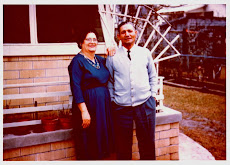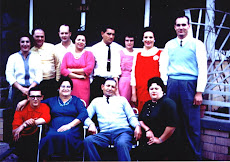 Last month, I went to Paris. I love that city. You would think that I must have some French blood in my veins, some atavistic instinct that draws me back there again and again.
Last month, I went to Paris. I love that city. You would think that I must have some French blood in my veins, some atavistic instinct that draws me back there again and again.But nope, I'm all Croat on my mom's side, Irish/Scotch/English/Cherokee by way of Tennessee on my dad's. Not a Gallic drop in me.
But I do have a French connection.
Years ago my mom told me that her aunt Tonica, my grandfather's sister for whom she was named, had married an artist and lived in Paris. He died. She returned to Croatia. She had sent my grandparents a book of his paintings, but because these included a bevy of nudes, it went on a top bookshelf where the kids couldn't see the naked women. The Hurricane of '47 took care of that book.
In 2008, I came face to face with those paintings in a wing of a museum in the town of Stari Grad. And I felt an instant sense of connection to my great-uncle-by-marriage, Juraj Plancic.
Like my grandfather, he was born into a family of fishermen on the island of Hvar. It became clear early on that he was born with natural artistic talent. Though he originally apprenticed as a barber, he eventually wound up in art school in Split and later studied under the noted sculptor Ivan Metrovic at the Academy of Fine Arts in Zagreb. He graduated in 1925 and earned a scholarship to study in Paris. He married his sweetheart, my great-aunt Tonica Soljan, and four days later, in November 1926, they arrived in Paris.
Paris in the 1920s was the Paris of Ernest Hemingway and F. Scott and Zelda Fitzgerald. Of Gertrude Stein and Alice B. Toklas. Of Picasso and Salvador Dali. Was Juraj part of this crowd? I somehow doubt it. Though an incredibly talented artist, he was a Dalmatian boy through and through. Reportedly shy, sensitive and prone to illness, he was also a devoted family man with the strong work ethic of the humble fishing folk he came from.
The early Paris years were lean ones for the young artist and his bride. Paris, so cold and grey in the winter, must have been a shock to them after Hvar with its turquoise waters, olive groves and rosemary scented sea air. Their living conditions were in a word squalid.
Like my grandfather, he was born into a family of fishermen on the island of Hvar. It became clear early on that he was born with natural artistic talent. Though he originally apprenticed as a barber, he eventually wound up in art school in Split and later studied under the noted sculptor Ivan Metrovic at the Academy of Fine Arts in Zagreb. He graduated in 1925 and earned a scholarship to study in Paris. He married his sweetheart, my great-aunt Tonica Soljan, and four days later, in November 1926, they arrived in Paris.
Paris in the 1920s was the Paris of Ernest Hemingway and F. Scott and Zelda Fitzgerald. Of Gertrude Stein and Alice B. Toklas. Of Picasso and Salvador Dali. Was Juraj part of this crowd? I somehow doubt it. Though an incredibly talented artist, he was a Dalmatian boy through and through. Reportedly shy, sensitive and prone to illness, he was also a devoted family man with the strong work ethic of the humble fishing folk he came from.
The early Paris years were lean ones for the young artist and his bride. Paris, so cold and grey in the winter, must have been a shock to them after Hvar with its turquoise waters, olive groves and rosemary scented sea air. Their living conditions were in a word squalid.

Inspired by his memories of home, he painted what was in his blood -- the boats returning from the sea, the vinters harvesting their grapes for wine. However, inspired by his new surroundings, he stretched beyond the pastoral scenes and still lifes of his training to experience the new colors which would become his trademark.
His hard work paid off. He was invited to show at salons, including an exhibition in his honor at the exclusive Gallery de Seine in 1929. His paintings sold. He accrued patrons. He and Tonica moved from the suburbs into the center of Paris.
But he never forgot where he came from.. He wrote home to a friend, "My greatest joy is when I paint our fishermen and our maritime world in general, which lives on land and sea My paintings are full of our merry sailors. These are stories I had heard as a child of my late grandfather, now I extract the fragments." *
In April 1930, he was diagnosed with tuberculosis. Knowing he had limited time, he painted feverishly up until his death, just four short months later, two months shy of his 31st birthday. He is buried in Thiais cemetery on the outskirts of Paris.
Tonica returned to Croatia with their infant daughter, Alice. She remained in Zagreb the rest of her life. My Aunt Dolores met her there, along with her daughter, grandchildren, two brothers and other family members in 1977.
Juraj went on to achieve immortality as one of Croatia's best-known artists. His work was shown posthumously in Paris and Zagreb. In 1960, the Gallery of Art in Split mounted a retrospective of his work which was hosted in several cities around the former Yugoslavia. In 1963, Tonica donated several of his paintings to the Art Collection of Juraj Plancic (now Juraj Plancic Gallery) located in the second floor of the Palace Biankini in their hometown of Stari Grad. I would see them there 45 years later.
And I was in awe.
* I found this on the blog http://dicocroate2.over-blog.com/article-juraj-plan-i--39573806.html
His hard work paid off. He was invited to show at salons, including an exhibition in his honor at the exclusive Gallery de Seine in 1929. His paintings sold. He accrued patrons. He and Tonica moved from the suburbs into the center of Paris.
But he never forgot where he came from.. He wrote home to a friend, "My greatest joy is when I paint our fishermen and our maritime world in general, which lives on land and sea My paintings are full of our merry sailors. These are stories I had heard as a child of my late grandfather, now I extract the fragments." *
In April 1930, he was diagnosed with tuberculosis. Knowing he had limited time, he painted feverishly up until his death, just four short months later, two months shy of his 31st birthday. He is buried in Thiais cemetery on the outskirts of Paris.
Tonica returned to Croatia with their infant daughter, Alice. She remained in Zagreb the rest of her life. My Aunt Dolores met her there, along with her daughter, grandchildren, two brothers and other family members in 1977.
Juraj went on to achieve immortality as one of Croatia's best-known artists. His work was shown posthumously in Paris and Zagreb. In 1960, the Gallery of Art in Split mounted a retrospective of his work which was hosted in several cities around the former Yugoslavia. In 1963, Tonica donated several of his paintings to the Art Collection of Juraj Plancic (now Juraj Plancic Gallery) located in the second floor of the Palace Biankini in their hometown of Stari Grad. I would see them there 45 years later.
And I was in awe.
* I found this on the blog http://dicocroate2.over-blog.com/article-juraj-plan-i--39573806.html
** For more Juraj Plancic paintings, visit http://wiki.cultured.com/people/Juraj_Plancic/


Cathy, found your posting this afternoon and I'm also a relative on the Croation side. We live outside of Seattle. Would be interested in further contact and discussing backgrounds. John@ARCcomm.com
ReplyDelete